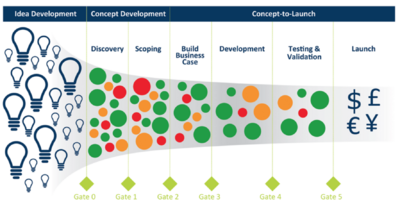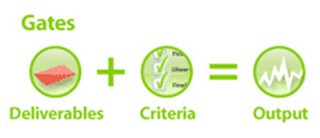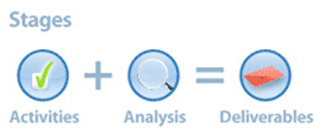Stage-Gate Model
Good Project Portfolio Management (PPM) is a key to success in New Product Development. A way to achieve this it is by implementing the Stage-Gate Model to help make better decisions when dealing with portfolio management. Stage-Gate was developed by Robert G. Cooper in the 1980´s. The model works as a structured method for product innovation, program or project, bringing ideas from concept to launch. Stage-Gate consists of five different stages[1]:
- Scope
- Building Business Case
- Development
- Testing & Validation
- Launch
Stages can be seen as a set of activities. Every stage consists of different activities that must be completed in order to move further to the next stage. The project team performing these activities consists of the workforce from different departments so that they can be done in parallel with each other. Working together in a cross-functional team will also contribute to increasing efficiency and effectiveness[2]. Between each of these stages, there are gates. Gates works as “decision points” or milestones, where the deliverables are brought up for quality control. This is most likely to be done by the top management or a decision-making team. When evaluating the deliverables they can either decide if the project should go forward, stop, hold or redo the current stage. Dealing with risk and uncertainty is often one of many pitfalls in projects. Stage-Gate takes this into account, as the risk and uncertainty will decrease the longer out in the process the project evolves. The is because the gatekeepers are evaluating the deliverables from every stage, and if they are not satisfied they can kill the project[1]. This is one of the benefits of the Stage-Gate process, which in the long run will assure that the company uses their resources at the right place.
The intention of this article is to share light on using Stage-Gate Model in Portfolio Management, describing the process and explain which criteria that must be fulfilled in order to achieve an effective portfolio[3]. Further, a walkthrough of the application is given showing which activities that should be performed in the stages. To sum up this article, strengths and weaknesses will be discussed.
Contents |
Introduction
Many of the world’s biggest firm benefits from using the Stage-Gate when dealing with idea conceptualization and bringing new products to market [3]. The first Stage-Gate model was developed by Robert G. Cooper in the 1980´s. Today, about 75% of all companies in U.S are using some sort of Stage-Gate when working with product innovation[2]. The Stage-Gate is meant to be a playbook for best practice on how to bring ideas from concept to launching [3]. The model brings the project through five different stages and between each of these stages are their gates. Gates are evaluating meetings where the deliverables from the previous stage are brought up for quality control. Further, it describes how a successful Stage-Gate process works in practice and how to manage it.
Today, the Stage-Gate model has been modified and adjusted, for the purpose of fitting all the new business models who have been developed through the recent years. Companies are calling this model NexGen Stage-Gate, where Cooper have implemented and taking into account different concepts such as making the process LEAN, as well as agile development and making the process more adaptable for open innovation [3][4].
Big idea

In order to make the Stage-Gate Model process work properly, it is critical that the company have set up the condition for this to work. The company must have defined a group of people that consist of key stakeholders from different departments and from the top management. This group will act as gatekeepers. They are the ones doing the quality control and deciding if the project should advance to the next stage [2]. Cooper said this about when choosing your gatekeepers:[3]
When defining gatekeepers, keep the number small - only the key resource owners - and try to keep "gatecrashers " out of the decision meeting. Since senior people's time is limited, consider beginning with mid-management at Gate 1, and for major projects, ending up with the leadership team of the business at Gate 3, 4 and 5.
As mentioned before should the project team in charge of bringing the idea from concept to launch consist of a group of cross-functional colleagues. Developing a successful new product and bringing in on the market is not a one department show. Skills and competencies from other departments are needed, hence the benefit of being a cross-functional team. The project team should, therefore, consist of people who have the necessary skills in R&D, marketing, production, business and engineering [1]. To ensure that the team is using their resources on doing the right things in the most efficient way should firms have implemented best practices and “how to” perform key tasks in each of the different stages. This is especially important for the project team when doing front-end analysis. It is very important that this process is solid in order to collect the data with the least waste of time and effort. The best practice will ensure that the data collected is not inconsistent and that it is gathered the same way in all kinds of projects. As a result of this will managing the portfolio will become much more effective[3].
Gates

As mention earlier, the purpose with gates is to evaluate the deliverables from the project team. Moreover, when evaluating the deliverables the gatekeepers have the opportunity to shut down projects, following “fail fast” philosophy, hence avoiding using unnecessary resources. All the gates are structured in the same way, consisting of three main elements:[1]
- Deliverables: Evaluate deliverables that the project team brings to the gate to see if it is performed after acceptable standards. Deliverables are containing results of all the activities that have been performed during the stage.
- Criteria: Each gate has a checklist of different criteria which the project is judged after. Some of these are “make it or break it” meaning if they do not meet these criteria the project will be killed.
- Outputs: The output from the gates decides if the project is giving a green light, red light, hold or recycle. In addition to deciding on the outcome of the project, the team must provide an action plan for the activities which are going to be carried out in the next stage, as well as a list of the next deliverables which is going to be evaluated on the next gate.
Stages
The main idea with the stages is to break product innovation into smaller pieces, doing one thing at the time. Each stage consists of activities, which are described in advance and should follow the companies best practice templates on how to perform these. The first process in the Stage-Gate model is initiated before stage 1, starting with an idea conceptualization, where the goal is to generate new ideas and/or business opportunities [1] [2].
Stage 1 - Scope

The purpose in this stage is to scope the project, without spending too much time and money, applying front-end analysis. The technical aspects of the project are looked into, as well as the market prospects[5]. Further, a quick assessment is done to determine what resources the project may need and whether the project will be valuable for the company[1].
Stage 2 – Building Business Case
Moving into the Building the Business Case stage, which is the most important and critical phase in the Stage-Gate Model[1]. To make sure that the project is going to be successful, a lot of time and energy must be put down developing the Business Case[5]. It is at this stage the project team will need the most resources. The Business Case must include a description of the product and project definition, project justification and a project plan[6]. Strategic goals are also decided upon, in order to achieve competitive advantages in the market, which also includes analysis of competitors.
Stage 3 – Development
Development of the product. The first thing to do is designing the product and is it very important that the design is as detailed as possible before it is produced. This including all the different specifications and customer needs. Simultaneously, market strategies and plans for launching the product is developed, as well as plans for testing the product, which is some of the deliverables needed in the next stage[7].
Stage 4 – Testing and Validation
The product is to be tested too, which can be very time consuming and contains several different testing stages. The necessary testing will cover performance and functionality tests, which are to be tested after given criteria’s and given requirements[1]. The purpose is to detect faults and quality deviations that could lead to the need for changes. Besides testing, stage 4 also cover validation of the whole project, including the work process up to this stage[7]. When validating the process, the project team will try to overcome possible group thinking, trying to raise awareness of possible threats, conflicts and opposing viewpoints on the project.
Stage 5 – Launch
The final stage, launching the product into the market. Starting processes such as production, commercials, marketing, sales, and operation[1].
Application – A walkthrough of the process
This section will show an example on how organizations can apply Stage-Gate model in their business. The focus here is not to go through the different stages, as was explained earlier, but moreover on which kind of activities that must be performed during the different stages. The example will be a bit superficial because there are so many different methods that can be applied. Stage-Gate Model is initiated in gate 1 where the main focus is on generating ideas. This is usually done with different brainstorming techniques to get the ideas flowing. The best idea is then brought to decision makers for their evaluation before it is brought into stage 1.
Stage 1 - Scope
Mostly, the project starts with preliminary analysis. This includes looking into the industry, market, economics and the consumer. To help determine whether the concept is feasible, a SWOT analysis (strengths, weaknesses, opportunities, threats) are carried out in order to investigate the strengths and weaknesses of the project. While a market analysis is done to help the team to see growing opportunities, state of the market, potential niche environments and possible threats. Once the scoping is done, the results are brought up to gatekeepers.
Stage 2 – Building Business Case
As mentioned before, building the good business case is vital for the project success. Some key elements that should be integrated with the business case are:
- Business and financial analysis
- Concept testing
- Risk management
- Market analysis and operations plan, including looking at user’s needs and preferences.
- Manufacturing plan
- Strategy
- Net Present Value (NPV)
Stage 3 – Development
Throughout the development stage, the project team executes plans from earlier stages. In order to physical develop the product, the development process includes three activities that can be characterized as: 1. Rapid prototype and test. 2. First prototype and test. 3. Next prototype and test.
As these tests are carried out, activities in parallel are also being carried out, such as costumer-feedback. The feedback act as an iterative process, going back and forth in-between the development stage, to secure that the opinion from the customer has been taking into account while producing the product.
Stage 4 – Testing and Validation
When the product is developed, it must be tested and validated. Not only the product but the feasibility of the project. This includes activities such as:
- Lab tests to confirm quality and performance.
- User trials
- Pilot production
- Pre-test market, simulated test market, full test market
- New business and financial analysis
Stage5 – Launch
Launching of the product into the market and implementation of the production plan produced in the previous stages. Targeting consumers
Strengths and weaknesses
It is difficult to point out some weaknesses or limitation directly linked to the model since it is supposed to act as a playbook for how to successfully take ideas and develop them to products. Companies who are failing to achieve success with product development using Stage-Gate model is often not failing because of the model itself. As a matter of fact, firms are failing because of how they are managing the process. Therefore are potential pitfalls and strengths listed below, gathered from an analysis carried out by Cooper[3][6][4].
| Strengths | Weaknesses |
|---|---|
| In order to have an effective portfolio management, it is necessary to have implemented the Stage-Gate Model. | Gates are not functioning as they should, which leads to too many poor projects being carried out. The analysis shows that only 33% of companies actually have properly functional gates. Moreover, it also shows that gates lack of teeth, and as a consequence of this is, projects are rarely killed at the gates. Further, will this lead to poor project passing through, and taking up unnecessary resources from the company. |
| Accelerates product to market. | Lack of defining gatekeepers. |
| Helps the firm concentrate on the right projects, or readdress poor projects, thus increasing the likelihood of success. | Gatekeepers behaving poorly. |
| Defining expectations at an early stage, hence, fewer mistakes are made, improved success rates, early detection of errors and shorter cycle times. | Being too much bureaucratic. Means, having meetings, procedures and mandatory activities that have nothing or little to do with the project. |
| Contribute to an efficient and effective allocation of recourses. | Defining the product and making the business case is the most critical part of the model, and it is at this stage most people lack knowledge. |
| Systematizes a normally chaotic process. | Overkill in deliverables or data integrity. |
| Break product innovation down into smaller pieces. | Not following the concept of the model, for example doing different stages at the same time. |
| Having a holistic view of the process, hence having cross-functional teams to perform the needed activities | |
| Increase efficiency, reduce the risk of redundancy and ensure that projects do not fall off the course during its development. |
Annotated bibliography
Supplementary information on references which are used in this article found from other scientific papers.
- The Stage-Gate Idea-to-Launch Process-Update, What's New and NexGen Systems. The article focus on the many misconceptions and challenges in using Stage-Gate. It also looks at the next generation of Stage-Gate where firms are adjusting the model to be more adaptable for concepts like open innovation, value stream and lean. Moreover, it gives valuable knowledge on portfolio management using Stage-Gate.
- The seven principles of the latest Stage-Gate method add up to a streamlined, new-product idea-to-launch process. Give the reader on how to best manage innovative product development by following seven principles. The seven principles were developed by studying American Productivity & Quality Center, and what they found was; Customer focused, Front-end loading, Spiral development, Holistic - effective cross-functional teams, Metrics, accountability, and continuous improvement, Focus on portfolio management, A lean, scalable, and adaptable process.
- Phase model for product development. Article developed by a professor at the Norwegian University of Science and Technology. It describes success criteria for product development and market launch as well as the importance of a process model when it comes to product development.
References
- ↑ 1.00 1.01 1.02 1.03 1.04 1.05 1.06 1.07 1.08 1.09 1.10 1.11 https://www.stage-gate.com/resources_stage-gate_full.php., The official site of Stage-Gate, Last visited 29-09-2014
- ↑ 2.0 2.1 2.2 2.3 G. Cooper, Robert and J. Edgett, Scott Best Practices in the Idea-to-Launch - Process and Its Governance , Research Technology Management, April, 2012
- ↑ 3.0 3.1 3.2 3.3 3.4 3.5 3.6 3.7 G. Cooper, Robert, The Stage-Gate Idea-to-Launch Process-Update, What's New and NexGen Systems, Journal of Product Innovation Management Volume 25, Number 3, 2008
- ↑ 4.0 4.1 G. Cooper, Robert, What Leading Companies are Doing to Reinvent their NPD Processes , PDMA Visions Magazine, September, 2008
- ↑ 5.0 5.1 Hjeltnes, Tor Atle, Fasemodell for produktutvikling., https://www.ntnu.no/iie/fag/mop/Modul%202/mop-ls2-fasemodell-2014v.pdf, 2014
- ↑ 6.0 6.1 G. Cooper, Robert, The seven principles of the latest Stage-Gate method add up to a streamlined, new-product idea-to-launch process., https://www.stage-gate.net/downloads/working_papers/wp_23.pdf, March, 2006
- ↑ 7.0 7.1 G. Cooper, Robert, Stage-Gate New Product Development System: A Game Plan from Idea to Launch , Ivey Business Journal, August, 2000